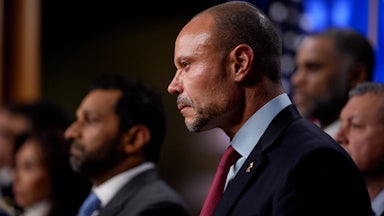The Supreme Court allowed the Trump administration’s ban on transgender soldiers in the military to take effect on Tuesday, sending an ominous signal about the future of transgender rights in general in the United States.
Justice Department officials asked the justices last month to override a temporary injunction issued by a federal judge in Seattle that had blocked the ban from taking effect. The Ninth Circuit Court of Appeals had previously declined to lift the injunction. Tuesday’s order by the high court cleared the legal barriers to enacting the new policy.
Justices Sonia Sotomayor, Elena Kagan, and Ketanji Brown Jackson indicated that they had dissented from the Supreme Court’s unsigned decision but did not write separately to explain their reasoning. The majority’s order also came without a written opinion, as is common with cases heard on the court’s emergency “shadow” docket.
The court’s decision will affect around 4,200 active-duty soldiers who have been diagnosed with gender dysphoria. Beyond the military implications, the justices’ intervention also bodes ill for other ongoing cases that could affect transgender Americans, most notably a pending ruling on whether the Fourteenth Amendment’s equal protection clause forbids discrimination on the basis of gender identity.
The case, United States v. Schilling, stems from an executive order signed by Trump one week after he took office in January. It directed the secretary of defense to develop a policy that would exclude future transgender recruits and remove active-duty transgender soldiers from military service. Trump’s order claimed, among other things, that transgender Americans lack the honor necessary to serve in the U.S. armed forces.
“Beyond the hormonal and surgical medical interventions involved, adoption of a gender identity inconsistent with an individual’s sex conflicts with a soldier’s commitment to an honorable, truthful, and disciplined lifestyle, even in one’s personal life,” the executive order argued. “A man’s assertion that he is a woman, and his requirement that others honor this falsehood, is not consistent with the humility and selflessness required of a service member.”
Transgender Americans have actually been serving their country honorably for some time. The Obama administration allowed transgender Americans to serve openly in the armed forces in 2016. In 2018, then–Secretary of Defense James Mattis issued a policy memo that disqualified soldiers who had undergone gender transition from military service, claiming it would affect unit cohesion. At the same time, it included a variety of exceptions that allowed other transgender soldiers to stay in the armed forces. President Joe Biden repealed Mattis’s memo within days of taking office in 2021, restoring the Obama-era policy landscape.
After Secretary of Defense Pete Hegseth issued his own policy guidance to enact Trump’s order in February, a group of transgender soldiers sued the Department of Defense to block it from taking effect. Their service records contradict the White House’s assertions that transgender Americans are inherently unfit for military service. The seven named plaintiffs in the case noted that they have been “awarded over 70 medals for their honorable service and distinctive performance—in many instances after coming out as transgender” and accumulated more than a century of collective military service.
“Thousands of transgender people serve in our nation’s armed forces,” they told the justices, in a brief earlier this month. “They have served—and continue to serve—with honor and distinction. It is a statistical certainty that transgender servicemembers have sacrificed their lives defending our country. Yet [Executive Order] 14183 and the Hegseth Policy seek to purge all of them from our military solely because they are transgender.”
Antidiscrimination protections for transgender Americans in federal law are inconsistent at best. In 2020, the Supreme Court held that language in Title VII of the Civil Rights Act of 1964, which prohibits workplace discrimination “on the basis of sex,” also covered sexual orientation and gender identity. Congressional Democrats introduced the Equality Act to extend those protections to other federal antidiscrimination laws but failed to pass it before Republicans retook the House in the 2022 midterms.
This decision comes at a precarious time, as the future of constitutional protections for transgender Americans are also an open question at the moment. Under the Supreme Court’s precedents, the Fourteenth Amendment’s equal protection clause requires a higher standard of judicial scrutiny when the government enacts laws and policies that affect certain groups of people. Race, religion, and national origin are among the categories considered “suspect classifications,” meaning that laws discriminating along those lines receive the strictest possible scrutiny from judges. Laws that discriminate on the basis of a person’s sex also receive a heightened form of scrutiny.
The Supreme Court is currently debating whether to treat gender identity as a suspect classification, in the pending case United States v. Skrmetti. (More on that one later.) But even when a group is not considered a suspect classification, it can still receive a measure of constitutional protection from laws that target it. In the 1996 Romer v. Evans, the justices overturned a Colorado constitutional amendment that denied any antidiscrimination protections to gay, lesbian, or transgender residents.
Justice Anthony Kennedy, writing for the court, held that the justices need not apply a heightened level of judicial scrutiny because the amendment could not survive even under rational-basis scrutiny, one of the easiest thresholds for the government to meet. “Its sheer breadth is so discontinuous with the reasons offered for it that the amendment seems inexplicable by anything but animus toward the class that it affects; it lacks a rational relationship to legitimate state interests,” he wrote in his majority opinion.
A federal district court in Washington state ultimately sided with the soldiers in Schilling, who asserted a range of equal-protection and due-process violations. Judge Benjamin Settle largely agreed with them by echoing Kennedy’s reasoning in Romer. He noted that the government had provided no evidence to support its claims that transgender soldiers, as a whole, “lack honesty, humility, and integrity,” and instead told the courts that they must automatically defer to the Pentagon’s judgment.
“Because the military has operated smoothly for four years under the [Biden-era policy], any claimed hardship it may face in the meantime pales in comparison to the hardships imposed on transgender service members and otherwise qualified transgender accession candidates, tipping the balance of hardships sharply toward plaintiffs,” Settle wrote. “There can be few matters of greater public interest in this country than protecting the constitutional rights of its citizens.”
Other federal judges have castigated the Trump administration for its flimsy rationales for imposing a ban. Judge Ana Reyes, a federal district court judge in the District of Columbia who heard a similar legal challenge, criticized the Justice Department’s lawyers in March for not reading the academic studies cited by Hegseth’s memo, which she described as “cherry-picked” and Hegseth’s portrayal of them as “misleading.”
Since the Supreme Court did not explain its reasoning in blocking Settle’s injunction, one can only speculate about its rationale. But it does not require much of a logical leap to conclude that things look dire for transgender Americans at the high court. One factor that courts use when considering a preliminary injunction is whether one is necessary to preserve the status quo while litigation continues. Denying it in this case will allow the Pentagon to discharge transgender soldiers from the military—precisely the kind of “irreparable harm” that injunctions are designed to prevent.
Courts also look at which side is most likely to succeed on the merits of their case when issuing a preliminary injunction. That look is not necessarily conclusive for a case’s outcome, but it can be indicative. In Schilling, a majority of the justices apparently do not think the transgender plaintiffs are likely to prevail on their equal-protection and due-process claims. That would track with the justices’ signals in oral arguments in Skrmetti last December, where they appeared ready to rule that laws targeting gender identity are not eligible for heightened scrutiny under the equal protection clause.
It is telling that the justices did not wait until Skrmetti to release Tuesday’s orders, even though it could be directly implicated by the results of that case. That outcome makes the most sense if the court is already aware that its pending ruling in Skrmetti will not affect how the lower courts approach Schilling. After all, if the court were on the verge of delivering a landmark ruling in favor of transgender rights in Skrmetti, it almost certainly would not have allowed the ban to go into effect in Schilling.
Finally, it is notable that even Romer’s reasoning—that a law or policy violates the equal protection clause when it serves no rational purpose other than to harm a specific group of Americans—apparently held no weight among the justices. The Trump administration has made no secret of its animus toward transgender Americans. At least some of the justices appear to openly share that hostility. The Supreme Court’s silent allowance is an ominous sign for its own future actions—and a green light to the Trump administration when it comes to discriminating against transgender Americans elsewhere.










